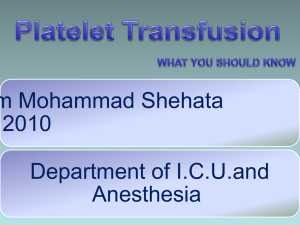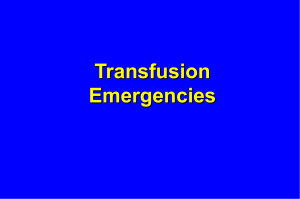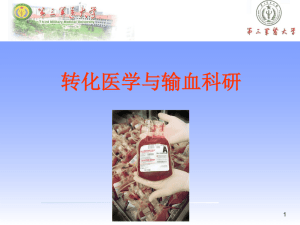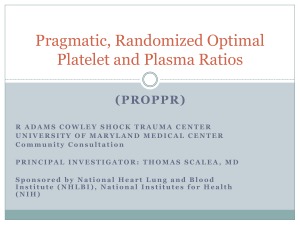Blood Component Therapy
advertisement
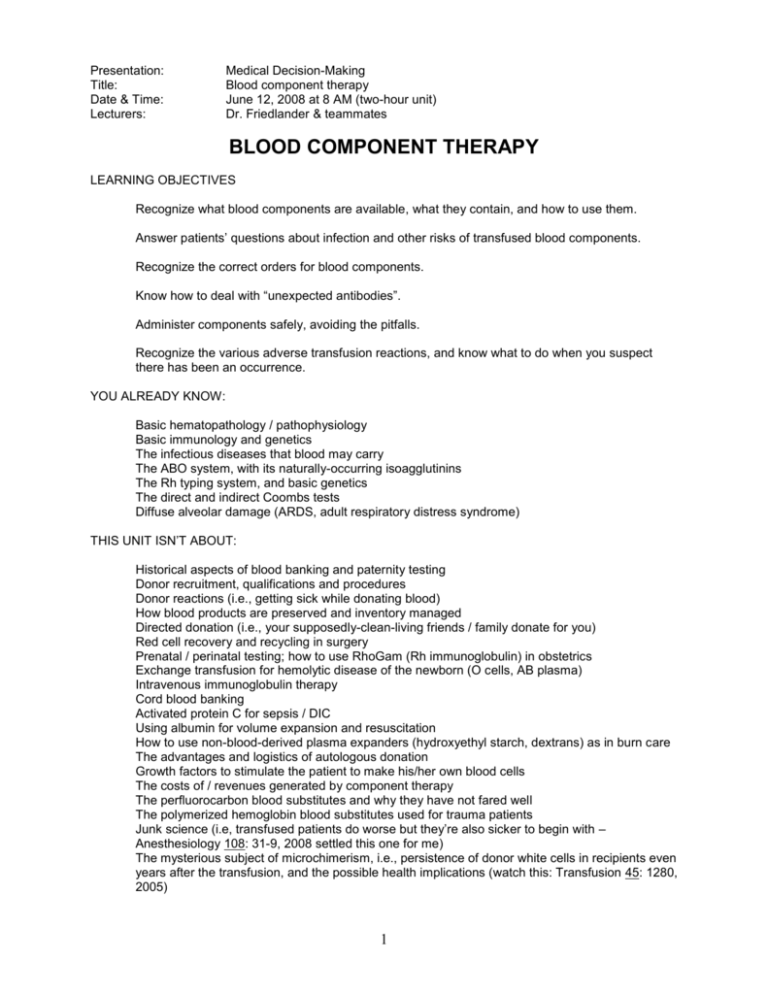
Presentation: Title: Date & Time: Lecturers: Medical Decision-Making Blood component therapy June 12, 2008 at 8 AM (two-hour unit) Dr. Friedlander & teammates BLOOD COMPONENT THERAPY LEARNING OBJECTIVES Recognize what blood components are available, what they contain, and how to use them. Answer patients’ questions about infection and other risks of transfused blood components. Recognize the correct orders for blood components. Know how to deal with “unexpected antibodies”. Administer components safely, avoiding the pitfalls. Recognize the various adverse transfusion reactions, and know what to do when you suspect there has been an occurrence. YOU ALREADY KNOW: Basic hematopathology / pathophysiology Basic immunology and genetics The infectious diseases that blood may carry The ABO system, with its naturally-occurring isoagglutinins The Rh typing system, and basic genetics The direct and indirect Coombs tests Diffuse alveolar damage (ARDS, adult respiratory distress syndrome) THIS UNIT ISN’T ABOUT: Historical aspects of blood banking and paternity testing Donor recruitment, qualifications and procedures Donor reactions (i.e., getting sick while donating blood) How blood products are preserved and inventory managed Directed donation (i.e., your supposedly-clean-living friends / family donate for you) Red cell recovery and recycling in surgery Prenatal / perinatal testing; how to use RhoGam (Rh immunoglobulin) in obstetrics Exchange transfusion for hemolytic disease of the newborn (O cells, AB plasma) Intravenous immunoglobulin therapy Cord blood banking Activated protein C for sepsis / DIC Using albumin for volume expansion and resuscitation How to use non-blood-derived plasma expanders (hydroxyethyl starch, dextrans) as in burn care The advantages and logistics of autologous donation Growth factors to stimulate the patient to make his/her own blood cells The costs of / revenues generated by component therapy The perfluorocarbon blood substitutes and why they have not fared well The polymerized hemoglobin blood substitutes used for trauma patients Junk science (i.e, transfused patients do worse but they’re also sicker to begin with – Anesthesiology 108: 31-9, 2008 settled this one for me) The mysterious subject of microchimerism, i.e., persistence of donor white cells in recipients even years after the transfusion, and the possible health implications (watch this: Transfusion 45: 1280, 2005) 1 TESTING OF DONOR UNITS: ABO -- forward and reverse Rh -- include test for weak D (Du) if negative (Allo-)Antibody screen Hepatitis B (1 infection per ~200,000 to 500,000 units; we check HbsAg and anti-HBc) Anti-HCV and hepatitis C NAT (“nucleic acid technology”; window ~25 days; risk from a transufused unit is now around 1 in 2 million) Anti-HIV-1 & HIV-2 and NAT (window is ~10 days; risk from a unit is now around 1 in 2 million; only 3 US donors have ever been found to have HIV-2 and evidently nobody’s caught it) West Nile virus RNA. Since we started measuring, there have been no more cases. Anti-HTLV I / II (risk of getting HTLV I/II is about 1 in 3.0 million; no one knows whether HTLV-II even causes disease in humans) Serologic test for syphilis (theoretical risk only) Malaria is kept out of the blood supply by donor screening. There is no convenient test; transmission rate is supposed to be around 1 in 4 million units transfused. Parvo B-19 testing is under investigation; the danger is to the unborn child. We do not screen for hepatitis A, since during the viremic phase you are probably symptomatic, and the disease is non-lethal. No one knows the risk for herpes 8, hepatitis G, Lyme disease, prion disease, or Chagas disease. The vast majority of donor units are separated into packed red cells (removed first by slow centrifugation), platelets (removed second by fast centrifugation), and either fresh frozen plasma or cryoprecipitate. WHAT IS AVAILABLE? Whole blood No components have been removed. The red cells are perfectly fine. Since it’s been stored in the refrigerator, the platelets are useless and factors V and VIII-C are greatly reduced. Don’t ask for whole blood. * Modified whole blood Only cryoprecipitate has been removed. Another obsolete product. (Packed) red cells The red cells from a donor unit, diluted with plasma to a hematocrit of about 75%. Volume is about 200 mL. Storing red cells (just above freezing) allows survival for 42 days, but unfortunately decreases 2,3-DPG and ruins the platelets and neutrophils. Today’s cost is $300/bag. Giving packed red cells is the fastest way to increase the oxygen-delivering capacity of the blood. A unit of whole blood or packed red cells will raise the hematocrit by 3% and the hemoglobin by 1 gm/dL. 2 Obviously you do not give red cells if there is another way to treat the anemia (i.e., iron, folic acid, B12, B6, perhaps erythropoietin). “Universal donor” for the ABO system is group O; “universal recipient” is group AB. “Oneg” or “type specific” red cells still sometimes get used in an emergency. Red cell aliquots: For babies. 10-25 mL units. Rx 5 mL/kg will raise Hgb by ~1 gm/dL. Irradiated red cells: Packed red cells, gamma-radiated to kill the lymphocytes. The lack of T-cells prevents graft-vs-host disease. Use this for your severely immunocompromised patients, lymphoma patients, stem-cell / marrow transplants, unborn children undergoing intrauterine transfusion, persons receiving blood from close “blood relatives” (family, inbred populations). Your lecturer thinks that, thanks to all the recent talk about microchimerism after pregnancy and blood transfusion, that someday we will nuke all cell-containing components. “Leukoreduced” red cells (“filtered” and/or “washed” red cells) Packed red cells, with 99.9% of white cells filtered out (pre- or post-storage) or removed by freezing/thawing/washing. The use of “LeukoPoor filters” is becoming very popular. These reduce (but don’t eliminate) the risk of CMV, Epstein-Barr, HTLV, and febrile reactions. If your patient tends to get nonhemolytic febrile reactions, consider leukoreduced red cells. The freeze-thaw-wash cycle removes plasma, which make this very useful for IgA deficient people (i.e., those allergic to IgA) and paroxysmal nocturnal hemoglobinuria patients (less complement). It will NOT prevent graft-vs.-host disease in the vulnerable patient. You have been warned. Frozen deglycerolized red cells Storage form (autologous donation, rare types, national emergencies). No leukocytes, platelets, or plasma. Because the deglycerolization opens the container and allows the entry of bacteria, they must be administered within 24 hours. Granulocyte concentrates Obtained by apheresis from family members for administration to cancer patients. Today, the donors are pre-treated with recombinant G-CSF and dexamethasone to increase the number of granulocytes harvested. 3 Platelet concentrate (“random donor platelets”) Platelets from a single donor unit. The volume is about 60 mL, and there are about 5.5x1010 platelets in a unit. Platelets must be stored at room temperature, so are good only for 5 days or less. One unit will usually raise the platelet count 5k-10k/microliter. Check one hour after transfusion. If the platelet count does not increase as expected (“refractoriness”), suspect DIC or immune platelet destruction (anti-HLA). If your patient has TTP, hopefully you didn’t administer platelets. Platelet aliquots For babies. Tiny bags. Leukoreduced platelets Single-donor platelets (often HLA-matched): Obtained by apheresis. There are six times as many platelets in one of these units as in a random-donor unit. Larger volumes and HLA-compatibility results in an increase of 30k-60k. Single-donor plasma / fresh frozen plasma “Plasma transfusion.” Rich in the clotting factors, proteins C and S, complement, and immunoglobulins. It reverses coumarin effect, replaces clotting fators, and is okay for HUS/TTP. It takes about 30 minutes to thaw. Of course there is an infection risk. “Universal donor” for plasma is group AB; “universal recipient” is group O. This seldom comes up in practice. Since there are no red cells in fresh-frozen plasma, Rh does not matter. IgA deficient fresh frozen plasma May be available for people allergic to IgA Plasma / Liquid Plasma This is fresh-frozen plasma that has been thawed but not immediately administered. It soon becomes depleted of factors V and VIII. Cryoprecipitate Rich in factor I, factor VIII-C, vonWillebrand’s factor, and factor XIII. Remember you don’t want to use this for TTP/HUS (why not?) Cryoprecipitate-poor plasma (“cryosupernatant”) The plasma left over when cryoprecipitate is prepared. Promoted for use for TTP a few years back (why?), probably it offers no advantage over fresh frozen plasma. 4 Novo-Seven: Recombinant activated factor VII. Especially for patients with hemophilia A or B with antifactor VIII antibodies (inhibitors) who must undergo major surgery. Watch for other uses of this new product. Factor VIII concentrate: From pooled blood or recombinant. In the US today, pretty much everybody gets the recombinant stuff. Factor IX concentrate Factor XIII concentrate Immune serum globulin (“gamma globulin”) Today it is solvent / detergent treated to remove hepatitis C and whatever else. Albumin Your hospital may stock “plasma protein fraction” (Plasminate), normal serum albumin (from pooled plasma, sterilized with solvent/detergent), or both. No infection risk. Antithrombin III concentrate: Recombinant product for those with hereditary deficiency CMV-negative blood products These may be offered for pregnant women who are CMV-negative, unborn babies and newborns, and the immunocompromised. TREAT THE PERSON, NOT THE LAB VALUES Most people with a hemoglobin of 7 gm/dL do fine in the short run unless they are in heart failure Even the super-sick can usually tolerate a hemoglobin of 10 gm/dL. Children with right-to-left cardiac shunts do best with hemoglobin 13 gm/dL or more. Studies showing a benefit of treating anemia more aggressively in CHF have used erythropoietin and correction of iron deficiency rather than transfusions. Target platelet counts (assume no functional defects): Actively / seriously bleeding: Before surgery or a big procedure: Asymptomatic outpatient: Hospital patient with fever: Hospital patient without fever: 100,000 platelets / microliter 50,000 20,000 10,000 5,000 One mL/kg of fresh frozen plasma increases the concentration of each clotting factor by 1%. 5 ORDERING AND PRE-TRANSFUSION TESTING If at all possible, you should obtain informed consent before administering any blood component. Except in a dire emergency, we crossmatch units of red cells prior to administration. Today we do only the major crossmatch, testing donor red cells against recipient serum to be sure that there is no antibody waiting to destroy the infused red cells. If your patient has autoimmune hemolytic anemia, the blood bank may also identify the autoantibody, and we might be able to get red cells that are negative for the autoantigen. Patient samples sent to the blood bank must be in EDTA tubes (purple, rarely pink). Why? Band and hold The blood bank gets a tube of blood for safekeeping and the patient gets just a wristband. This is fine when there’s a remote possibility that a stat transfusion will be needed (i.e., cardiac caths, low-risk childbirth). Type and screen You have decided your patient may need blood while he/she is in the hospital, but you are not going to reserve any particular units yet. Mostly you want to see if it will be difficult to find blood for your patient (i.e., does he/she have an unexpected antibody?) You will get the wristband, a forward ABO typing (i.e., what ABO antigens are present on my patient’s red cells?) and reverse ABO typing (i.e., what ABO isoagglutinins are present in my patient’s serum?) Sometimes these do not match; let us worry about this. You also get the Rh type (i.e., is D present or absent on the red cells?) There will also be a screen of the plasma for all the major alloantibodies. (How do you think we do that?) Nowadays, an immediate-spin crossmatch allows release of blood within 5 minutes, so often “type and screen” is much better than “type and cross” for making the whole hospital more efficient. Type and cross(match) ([x] number of units) As “type and screen”, but there is a fair chance you’ll transfuse your patient. You want [x] number of units crossmatched so they will be immediately available. Type and hold [x] number of units Like “type and cross”, but nobody else can have the units. This is going out of fashion. “The lab found that my patient has an antibody.” These are non-ABO antibodies that may occur naturally, or as a result of transfusion or pregnancy. Less important are autoantibodies like the IgM anti-I that often follows Mycoplasma infection. If the antibody is against a very low frequency antigen, you probably won’t find it and even if you do, it probably won’t be a problem. If the antibody is against a fairly high-frequency antigen, there will be a delay (minutes to hours) finding compatible units but it will probably be possible to match your patient. 6 If the antibody is against a very high-frequency antigen, it’s trouble. In an emergency, the blood bank will call the government for help. Afterwards, recruit family as donors, discuss autologous donation, and so forth. Some of the common problem alloantibodies: anti-i: The antigen is lost on most adults, and finding compatible blood is easy. anti-I: Cold agglutinin. anti-Rh (anti-c, anti-C, anti-D, anti-e, anti-E, others): Common and dangerous; usually IgG, and produce a delayed hemolytic transfusion reaction anti-Kell: after ABO and Rh, Kell is the most immunogenic group anti-Duffy (Fya, Fyb) anti-Kidd (Jka, Jkb): Kidd B is infamous for producing severe reactions “even though there wasn’t any antibody present before the transfusion” anti-Lewis: commonly detected, but not so dangerous. They are not integral membrane proteins, and are adsorbed from the plasma, so the donor RBC’s change to match the patient. Cold agglutinins: The one legitimate reason to pre-warm blood. Ask the IV team. THE ADVERSE EFFECTS OF BLOOD TRANSFUSION Risks from a unit of ordinary red cells: Non-hemolytic febrile transfusion reaction: 1-2% (0.1% for those pre-treated with acetaminophen) Minor allergic: 1-2% Real anaphylaxis: maybe 1 in ~20,000; estimates vary greatly; fatality rate unknown Transfusion-related acute lung injury (“TRALI”): 1 in ~1000; fatality rate <1% with estimates for both numbers varying widely Hemolytic transfusion reactions: Immediate: 1 in ~25,000; fatality rate 10% Delayed: 1 in ~6000; fatality rate 0.1% Sepsis: 1 in 1 million, fatality rate 60% All in all, one red cell unit in 100000 causes death in the acute setting. I join others who believe that the most common cause is TRALI. Immediate hemolytic transfusion reaction A disaster, but almost always preventable. Most often due to ABO mismatch due to a clerical error (i.e., the wrong blood and/or the wrong recipient). As you’d expect, there is shock, free hemoglobin in the serum, hemoglobinuria, and pain at the infusion site (potassium). Stop the transfusion as soon as you suspect this, even if it’s just the patient feeling bad or getting a temperature. Keep the vein open by running in saline. Draw your post- 7 transfusion samples (one red-top tube, one purple-top tube, why?), check the urine for hemoglobin, and notify the blood bank. Save the untransfused blood. Give mannitol to keep the kidneys open, monitor for DIC. You can confirm that there has been hemolysis by spinning a hematocrit tube on the ward and looking for pink plasma. The lab will measure LDH, indirect bilirubin, serum hemoglobin, haptoglobin (why?), fibrin split products, Coombs testing, repeat crossmatch, bacterial culture, check for clerical errors. Delayed hemolytic transfusion reaction Not preventable. A new antibody or anamnestic response has probably developed. These present 1-4 weeks after the transfusion with flu-like symptoms and jaundice. The lab will work this up in the same way as an immediate hemolytic transfusion reaction. The patient will be sick for a few days, but deaths are very uncommon. Febrile nonhemolytic transfusion reaction Defined to be a rise in temperature of 1oC or more and >=38 oC, within 24 hours of transfusion, but without evidence of a hemolytic transfusion reaction. These reactions are due to cytokines in the blood itself and/or produced in the patient from sensitivity to the HLA molecules on platelets and white cells. If your patient tends to get these, give leukoreduced blood and/or an antipyretic before the transfusion. Allergic / urticarial transfusion reactions Some folks get “hay fever / hives / wheezing” from transfusions; you can continue the transfusion when they are better, which is soon, and in the future, pre-treat with an antihistamine. Anaphylactic / anaphylactoid reactions Very fast, spectacular illness after transfusion only a few mL. Usually due to IgA deficiency in the recipient. Transient hypotensive People on ACE inhibitors, from bradykinin in stored red cell units. Transfusion induced acute lung injury / TRALI (“noncardiogenic pulmonary edema”) Defined to be ARDS within 6 hours of a transfusion with no other clear cause. Most often this happens in patients transfused in surgery or the ICU, especially if plasma was administered. The pathophysiology is being worked out. The cause is apparently antibodies in the donor plasma against the patient’s neutrophils (which, in the sick, are marginated in the lung vessels). The donor antibodies cause these neutrophils to release toxic products and thus produce ARDS. Treatment is supportive. Most patients survive. Some do not. 8 Transfusion-associated circulatory overload (“TACO”) In those with marginal cardiac function. Be careful. Post-transfusion purpura Happens 7-10 days after transfusion; due to production of anti-HPA-1a by those lacking the antigen against donor and recipient platelets Transfusion-associated graft-vs.-host disease This happens in the unborn, when the recipient has congenital or iatrogenic absence of T-cells, or when there is a perfect HLA match between donor and recipient. This is notoriously untreatable and will almost always kill the patient at about 4 weeks. Be sure to use radiated blood for anyone who may not be able to reject a stranger’s Tcells. Electrolyte toxicity (i.e., potassium) A real danger for newborns; one may prefer washed red cells. If hemolyzed blood is administered (i.e., the blood was left on the radiator or the warmer was too hot), the result will be catastrophic. Iron overload Each unit of red cells brings 200-250 mg of Fe. If you have more than 20 gm of iron on board (i.e., 100 units as for thal major or aplastic anemia), you will probably be seriously sick from it. Bacterial contamination Yersinia and Pseudomonas can grow in blood despite refrigeration. Don’t transfuse the green or purple units. Platelets (kept at room temperature during their 5-day shelf life) are a great culture medium, especially for skin staphylococci from the venipuncture. Watch for more work on UV radiation-plus-psoralen treatment of platelets. Culturing bags at two days was introduced in the US in 2004 and seems to have cut serious bacterial infections from 1 in 33,000 to 1 in 75,000. Alloimmunization Especially, the more you have been transfused, the more likely you are to destroy the next unit of donor platelets. Immunosuppression / immunomodulation No one understands it. A transfusion renders the recipient somewhat more immunotolerant. Mostly a research area. Citrate toxicity Tingly lips and fingertips from citrate binding calcium. From rapid infusion of the product or liver failure. 9 Hypothermia Red cells and fresh frozen plasma are chilly. An extra blanket is much safer than an electric warming coil, even “the special warmers for blood that don’t go over 104 o F / 40o C. LAST THOUGHTS Historically, Jehovah’s Witnesses have been unable to accept donor packed red cells, platelets, white cells or plasma, and could not accept autologous or cell-cycled intraoperative transfusion. At this time, they can accept fractions (there is some difference of opinion as to what these constitute), and intraoperative cell salvage “as individual conscience allows”. At this time, members seem to be free to accept albumin, cryoprecipitate, and factor concentrates. The sect reversed its prohibition on polymerized hemoglobin in 2000 (South. Med. J. 97: 1257-8, 2004). The sect leadership used to be militantly anti-immunization, anti-germ theory, and antitransplantation as well, but that changed long ago. The health consequences of JW’s refusal of red cells are nil for minor procedures and minor illnesses. I hope this does not surprise you. When blood is truly required, the outcomes are far worse than for non-JW’s – “living proof” that there’s still a need for the blood bank. Talk to your JW patients about blood before there is a crisis. As a physician, don’t argue matters of faith. But you may present the real facts (rather than disinformation), ask the person what pressures he/she is under to refuse transfusion, and explore whether this is truly what he/she wants. The JW-focused “bloodless surgery” programs are medically fascinating and very expensive, don’t have as good overall average results as those allowing transfusions, and raise questions about who should / will pay. Unlike activists for ____, ____, or ____, JW’s are only placing their OWN lives and health on the line, and they are NOT trying to interfere with science or medicine as it affects the lives and health of others. I respect (and honor) this and hope you will do so as well. Blood banking in the “developing world” is still very unsafe, with basically none of the protections that we have in the US. (Think about component therapy without reliable refrigeration.) The blood bank pathologist is the only businessperson in a community who works hard to REDUCE demand for his/her product. There are several reasons. Think about it. HCA MIDWEST DIVISION BLOOD BANKS PACKED RED CELLS Hemoglobin less than 8 gm/dL Preoperative hemoglobin less than 9 gm/dL and operative procedures or other clinical situations associated with major predictable blood loss Symptomatic anemia in a normovolemic patient Acute loss of at least 15% of estimated blood volume with evidence of inadequate oxygen delivery following volume resuscitation FRESH FROZEN PLASMA PT or PTT greater than 1.5 times the mean of the reference range (PT>16, PTT>39) in a nonbleeding patient scheduled to undergo surgery or invasive procedure Massive transfusion (more than 1 blood volume or 10 units) and coag tests are not yet available TTP or hemolytic uremic syndrome Emergency reversal of coumadin anticoagulation Coagulation factor deficiency when virus-inactivated concentrates are not yet available PLATELETS Platelet count less than 10,000 in a non-bleeding patient with failure of platelet production Platelet count less than 50,000 and impending surgery or invasive procedure, patient actively bleeding, or outpatient Patients during or after open heart surgery or intra-aortic balloon pump with diffuse bleeding 10 Massive transfusion (more than 1 blood volume or 10 units) when platelet counts are not available Qualitative platelet defect (bleeding time greater than 9 minutes) with bleeding CRYOPRECIPITATE Fibrinogen less than 100 mg/dL Fibrinogen less than 120 mg/dL with diffuse bleeding Von Willebrand disease or hemophilia unresponsive to desmopressin (DDAVP) and no appropriate factor concentrates available Uremic bleeding if desmopressin is ineffective Factor XIII deficiency * * * Cookbook is better than no-book. – Ed FURTHER READING Lancet 370)9585): 415-26, 2007. RBC transfusion review. Lancet 370)9585): 427-38, 2007. Platelet transfusion review. Arch. Path. Lab. Med. 131: 702-7, 2007. Infectious complications complications of transfusion, a megareview by the Red Cross Arch. Path. Lab. Med. 131: 708-18, 2007. Non-infectious complications complications of transfusion, a mega-review by the Red Cross Am. J. Clin. Path. 128: 945-55, 2007; Arch. Path. Lab. Med. 131: 719-33, 2007.. Although transfusion seldom transmits disease, doing things to the units that selectively destroy DNA and RNA might make things even safer. Crit.Care Med. 35: 2576-81, 2007. In the Iraq war zone, fresh whole blood and fresh red cells are sometimes administered in combat support hospitals. There are quick-screens for bad diseases, and the practice seems reasonably safe. J. Trauma 64(S2):S-92-8, 2008. Around half of heavily-transfused US soldiers in Iraq have microchimerism afterwards. Arch. Int. Med. 165: 845-852, 2005. How the pathologists and public health doctors at Ottawa got the internists and surgeons to use less blood. Arch. Path. Lab. Med. 130: 474-9, 2006. How the pathologists get the clinicians to stop transfusing blood inappropriately. Arch. Path. Lab. Med. 130: 1196-8, 2006. Around 0.5% of specimens sent to the blood bank for possible transfusion recipients contain at least one labeling error. J. Trauma 60(6): S-51-S-58, 2006. Empirically, giving platelets and plasma sooner rather than later in trauma with massive hemorrhage leads to less coagulopathy and better outcomes. Crit. Care. Med. 34: 1608-16, 2006. The folks at the Cleveland Clinic found out that the more packed red cells you received before your bypass, the worse your outcome. However, they could not really tell whether recipients were sicker to begin with (you think?), or whether the blood itself caused the problems. The data is from the pre-leukoreduction era. J. Trauma 60(6): S83-S90, 2006. By now, the benefits of routine leukoreduction are obvious. 11 Arch. Dis. Child. 90: 89-91, 2005. The English will only transfuse their own children with American plasma because of prion fears. Lancet 361: 161-9, 2003. Transfusion medicine’s future. Crit. Care Med. 33: 721-6, 2001. TRALI: consensus conference. Am. J. Clin. Path. 129: 287, 2008. TRALI review for pathologists. There is still no gold standard for the diagnosis. Favors today’s dominant thinking that most TRALI is caused by donor antibodies against recipient antigens, especially neutrophils. Suggests that pathologists also search for other “neutrophil primers” that might be present in banked blood. Chest 126: 249-58, 2004, and Blood 105: 2266-73, 2005, and Anesthaesia 61: 777-85, 2006 and Curr. Op. Hem. 12: 480-7, 2005 and Mayo Clin. Proc. 80: 766-70, 2005 and Blood 107: 1217, 2006. TRALI. The pathophysiology. There is now an animal model of the antibody-mediated neutrophil activation. Crit. Care Med. 35: 1645 & 1775, 2007. Mayo’s found that plasma from female donors is much more likely to cause TRALI than plasma from men. Can you explain why? (SURE you can!) Arch. Path. Lab. Med. 128: 279, 2004. Bacterial contamination of platelets. Arch. Dis. Child. 89: F101, 2004. Neonatal transfusion practice. Crit. Care Med. 31(12 S): S678-86, 2003. Risks of blood transfusion summarized. Arch. Path. Lab. Med. 128: 991, 2004. Acetaminophen premedication cuts the risk of febrile transfusion reactions to around 0.1%. Ped. Clin. N.A. 49: 1211-38, 2002. Blood transfusion for children. Ann. Thor. Surg. 72: S-1832-7, 2001. Blood transfusion: the silent epidemic. Iatrogenic disease. Ann. Thor. Surg. 72: S-1806-7, 2001. Dangers of red cell administration. NEJM 355: 1331-8, 2006. First strong evidence that Herpes 8 (Kaposi’s sarcoma virus) is transmissible by blood transfusion. Am. J. Med. 119: 1013, 2006. Clinical strategies for Jehovah’s Witnesses – an update. Crit. Care Med. 31: S-708-14, 2003. Bloodless surgery for Jehovah’s Witnesses. Nothing on the economics or comparative outcomes. Am. J. Card. 98: 1223, 2006. A retrospective, non-randomized study. It’s clear enough from the article that the fact that cardiac surgery outcomes in JW’s are now comparable to those of non-JW’s is possible only because of today’s blood conservation protocols, which usually prevent the need for transfusion during cardiac surgery in the first place. J. Am. Coll. Surg. 203: 412-7, 2005. and Ann. Surg. 240: 350-7, 2004. Liver transplantation can be accomplished without blood transfusion. However, it did require elaborate preparations, and also a great deal of intra-operative blood salvage and subcomponent use. The second article reviews risks and costs of today’s mainstream component therapies. Anaesthesia & Int. Care 32: 798, 2004; the JW program at Toronto. Trans. Med. 14: 241-6, 2004. Saving the life of a JW with abruption using PolyHeme. Hematology J. 5: 281-2, 2004. Recombinant VIIa saves a JW with a GI bleed. Anesth. and Analg. 104: 763-5, 2007. Recombinant VIIa is now well-established as a life-saver for JW’s. 12 Transfusion 42: 812-8, 2002. The extremely poor survival statistics for JW’s with hemoglobin levels <6 gm/dL. Transfusion 45: 1735-8, 2005. A JW with acute leukemia sets a world record by being transfused longterm with huge amounts of polymerized bovine hemoglobin, confirming its apparent safety. J. Med. Ethics 24: 231, 1998. An ethicist looks at the enormous costs and relatively poorer outcomes of the special programs for JW’s. Does society have a duty to cover the expense? No easy answers – and the same questions apply to many other kinds of life-choices as well. Arch. Gyn. Ob. 276: 339, 2007. In a Scottish practice where 6% of women lose a liter or more of blood at delivery, a not-very-scientific extrapolation estimated a JW’s risk of death in childbirth to be 65x a non-JW. BMJ 318: 873, 1999. The extra cost of a single Jehovah’s Witness “bloodless surgery” could have provided full funding for an African clinic caring for 500,000 people for an entire year. Ped. Hem. Onc. 24: 269-73, 2007. Hemopure (polymerized bovine hemoglobin) saves a JW toddler with sickle cell disease. http://www.ajwrb.org/ Associated Jehovah’s Witnesses for Reform on Blood. Those involved must keep their identities secret or be disfellowshipped and shunned. If you don’t know what “being shunned” entails, ask – and then consider once again the pressures that your “no blood” patient may be under. Blood 101: 2419, 2003. Even in Ghana, perhaps the most functional of the sub-Saharan African nations, blood banking is very primitive. Lancet 359: 494-5, 2002. Transfusion medicine in Kenya. Int. J. Inf. Dis. 5: 70-3, 2001. Transfusion medicine in Cameroon. JAMA 299: 2304-12, 2008. Cell-free hemoglobin-based blood substitute use seems to be associated with increased mortality, both from all causes and myocardial infarction. We could talk about this; this isn’t a controlled prospective study by any means, and these polymers are great for saving lives in remote areas. 13




